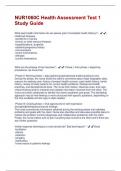NUR1060C Health Assessment Test 1
Study Guide
What past health information do we assess (part of complete health history)? - ✔️✔️-
childhood illnesses
-accidents or injuries
-chronic or other serious illnesses
-hospitalizations, surgeries
-obstetric/pregnancy history
-immunizations
-recent examinations
-allergies
-current medications
What are the phases of the interview? - ✔️✔️-Phase I: Intro phase = beginning
procedures, we know this!
-Phase II: Working phase = data gathering/open&closed ended questions only.
During this phase, the nurse elicits the client's comments about major biographic data,
reasons for seeking care, history of present health concern, past health history, family
history, review of body systems for current health problems, lifestyle and health
practices, and developmental level. The nurse then listens, observes cues, and uses
critical thinking skills to interpret and validate information received from the client. The
nurse and client collaborate to identify the client's problems and goals. The facilitating
approach may be free-flowing or more structured with specific questions, depending on
the time available and the type of data needed.
-Phase III: Closing phase = final opportunity for self-expression
(thoughts&feelings)/summarize findings.
The nurse summarizes information obtained during the working phase and validates
problems and goals with the client. Nurse also identifies and discusses possible plans to
resolve the problem (nursing diagnoses and collaborative problems) with the client.
Finally, the nurse makes sure to ask if anything else concerns the client and if there are
any further questions
Verbal response techniques a nurse should do? Bad techniques? - ✔️✔️Good
-facilitation
-silence
-reflection
-empathy
-clarification
*nurse reacts to patients feelings
,-confrontation
-interpretation/repeating
-explanation
-summarize
*focus is on nurses thoughts and feelings
Bad
-false assurance
-unwanted advice
-using authority
-avoidance language
-inappropriate distancing
-jargon
-leading/biased questions
-talking too much
-interrupting
-"why" or demeaning questions
Erickson's stages of development? - ✔️✔️
National CLAS standards (2013) were made to ensure patients receive culturally
competent care, how should health care organizations ensure this happens? -
✔️✔️Language should be:
-effective (ensure positive patient satisfaction & outcomes)
-easily understandable
-respectful (considering values, preferences, needs)
-compatible with their cultural health practices/beliefs and preferred language.
Interpreting should be done how? - ✔️✔️-the way it is Federally/legally mandated (ex-
free of charge, verbal and in-writing notices)
-not by family members
-by addressing the patient
-with the proper gender, age, and ethnic considerations
What are the main cultural assessments (there are 8 in our notes)? - ✔️✔️-Heritage
-Health Practices
-Communication
-Family Roles
-Death Rituals
-Nutrition
-Childbirth rituals
-Spirituality/Religion (FICA - faith, importance, community, action)
, The Title VI Civil Rights Acts prohibits what? - ✔️✔️Federally funded/assisted
programs cannot distinguish/discriminate among individuals on the basis of race, color,
ethnicity or national origin of the program.
What are some health literacy concerns? - ✔️✔️health literacy concerns:
-can patient remember verbal instructions?
-can patient navigate the health care system?
-can the patient communicate their concerns?
-is the patient showing compliance concerns and keeps having hospital re-admissions?
-are there cultural considerations that could be concerning?
Concerns to teaching the patient? - ✔️✔️-proper written materials? ex's are reading
level, font size, pictures, background color.
-proper oral teaching? ex's are syllables, terminology, familiarizing.
-teach back? are we asking the patient to repeat things back to us and demonstrate
they understand?
What are the 8 steps of the complete health history? - ✔️✔️(1) biographical data, such
as the patient's name, address, and date of birth, as well as language and
communication needs.
(2) note the source of the history, which is usually the patient but may be someone else,
such as a relative or interpreter.
(3) obtain the reason for seeking care, formerly referred to as the chief complaint (In the
patient's own words).
(4) record the current health or history of current illness. For a well patient, briefly note
the general state of health. For a sick patient, chronologically record the reason for
seeking care. When a patient reports a symptom, perform a symptom analysis
(PPQQRRSTU).
(5) investigate past health events, such as illnesses, injuries, hospitalizations,
operations, obstetrical history, immunizations, recent examinations, and allergies, as
well as current medications.
(6) gather a family history to help detect health risks for the patient. To aid in this
process, draw a family pedigree or genogram.
(7) perform a review of systems, which is a series of questions in order to identify many
signs and/or symptoms which the patient may be experiencing. We use this to get an
inventory of symptoms in all body systems. (Make sure to record symptoms in patient's
own words).
(8) perform a functional assessment, including activities of daily living, such as bathing
dressing, toileting, eating, walking, housekeeping, shopping, cooking, and other factors.




